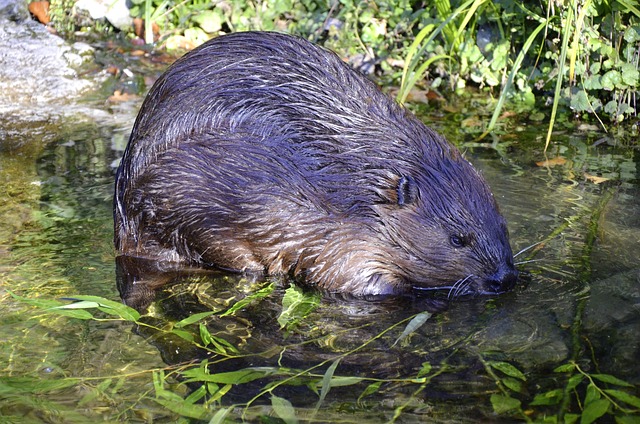Beavers are fascinating creatures well-known for their ability to build dams and lodges. However, little is known about their behavior regarding stress and panic. Do beavers panic easily? This is a question that has puzzled researchers for years.
Some studies suggest that beavers are highly adaptable creatures that can cope with various environmental stressors.
For example, they can adjust their behavior in response to changes in water flow, food availability, and predator activity.
However, other studies suggest that beavers may be more vulnerable to stress than previously thought.
This is particularly true regarding human activity, such as trapping and habitat destruction.
Understanding how beavers respond to stress is essential for their conservation and management.
By better understanding their behavior, researchers can develop more effective strategies for protecting these critical ecosystem engineers.
Do Beavers Panic Easily?
Beaver Response to Threats
Beavers are known for their ability to build dams and create wetland habitats. However, their survival also depends on their ability to respond to environmental threats. When beavers perceive danger, they may exhibit various behaviors, including fleeing, vocalizing, or attacking the perceived threat.
One study found that beavers are more likely to flee from potential predators than to attack them. When beavers feel threatened, they may slap their tails against the water to warn other beavers of danger. This behavior can also alert predators to the presence of beavers.
Factors that Affect Beaver Panic
Several factors can influence how easily beavers panic. For example, beavers may be more likely to panic if they are in an unfamiliar environment or if they have recently experienced a traumatic event.
Additionally, beavers may be more likely to panic if they are in poor physical condition or experiencing stress due to environmental factors such as drought or pollution.
Research has also shown that beavers may be less likely to panic if they are in a group. For example, in one study, beavers in groups were less likely to flee from a perceived threat than solitary beavers.
This suggests that beavers may feel more secure with other beavers and may be more likely to rely on their group for protection.
In conclusion, while beavers can respond to threats in their environment, they may not panic easily. Their response to threats may depend on various factors, including their physical condition, environmental stressors, and social context.
Beaver Behavior
Beavers are fascinating animals known for their impressive dam-building and lodging ability. They are also known for their unique behaviors, which are influenced by their habitat, diet, and social behavior.
Habitat
Beavers are primarily found in North America, Europe, and Asia. They prefer to live near bodies of water such as rivers, streams, and lakes. Beavers build their homes, called lodges, out of sticks, mud, and other natural materials. They also build dams to create ponds and slow down the flow of water.
Diet
Beavers are herbivores, which means they eat only plants. They prefer to eat the bark, leaves, and twigs of trees such as aspen, willow, and birch. Beavers also eat aquatic plants such as water lilies and cattails. They have strong teeth that allow them to chew through tough plant material.
Social Behavior
Beavers are social animals that live in family groups called colonies. A colony usually consists of a breeding pair and their offspring. Beavers communicate with each other through a variety of vocalizations, such as grunts, whines, and barks. They also use scent markings to communicate with other beavers in their territory.
In conclusion, beavers exhibit unique behaviors shaped by their habitat, diet, and social behavior. By understanding these behaviors, we can better appreciate these fascinating animals.
Threats to Beavers
Predators
Beavers have several predators that they must be wary of. One of the most common predators is the North American River otter. Otters are skilled swimmers and can easily catch beavers in the water.
Other predators include coyotes, bobcats, and black bears. These predators are more likely to target young or weak beavers, but they can also pose a threat to adult beavers.
Habitat Loss
Habitat loss is a significant threat to beavers. As humans expand into natural areas, beavers are losing their habitats. This can lead to a lack of suitable food and shelter, making it difficult for beavers to survive.
Additionally, the destruction of wetlands and waterways can impact the ability of beavers to build dams and lodges.
Climate Change
Climate change is also a significant threat to beavers. Changes in temperature and precipitation patterns can impact water and food availability for beavers.
In some areas, droughts may make it difficult for beavers to find enough water to build their dams and lodges. Additionally, temperature changes can impact the timing of seasonal events, such as the freezing and thawing of waterways, which can also affect beavers.
In conclusion, beavers face several threats in their natural habitats. Predators, habitat loss, and climate change are all significant concerns that can impact the survival of beaver populations. Humans need to be aware of these threats and take steps to protect beavers and their habitats.
Conclusion
In conclusion, the research on beavers suggests that they do not panic easily. Despite their timid nature, beavers have evolved to adapt highly to their environment. They have developed a range of behaviors that allow them to respond to threats calmly and composedly.
One critical factor contributing to the beavers’ calm demeanor is their ability to communicate effectively with each other. Through vocalizations, scent marking, and physical displays, beavers can signal danger to their colony members and coordinate their responses accordingly.
Moreover, beavers have several physical adaptations to defend themselves against predators. Their thick fur coats provide insulation and protection from the cold, while their sharp teeth and powerful jaws enable them to chew through wood and defend themselves against predators.
While beavers may be vulnerable to threats like habitat loss and hunting, they can generally maintain their composure in danger. As such, they continue to be an important and fascinating species for researchers to study and learn from.




